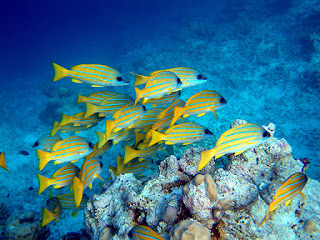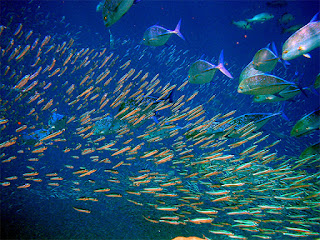Human parents everywhere breathed a sigh of relief this past month, as children headed back to their classrooms. With backpacks, pencils, and lunch bags in hand, kids trotted off to a new adventure, while parents enjoyed a daytime respite.
In honor of this special “season”, we thought we would visit schools of a different kind – schools that are always in session…. underwater!
What is a school of fish?
There are actually two types of fish aggregations, shoals and schools. A shoal is a looser group, sometimes consisting of different species that hang out together (often temporarily), but are disorganized. Schools are highly structured, with coordinated movements and a common direction. A group of fishes can switch from shoaling to schooling and back again.
Schooling fish are usually of the same species and the same age and size. Fish schools move with the individual members precisely spaced from each other! Who knew fish could do mathematics?
Why do fish school?
Schools protect fish from their enemies. It's the same rule our mothers taught us as kids- always stay in a group because there’s safety in numbers! Predators find it easier to chase down and eat fish swimming alone, rather than trying to extract a single fish from a huge group. The same holds true in reverse. Fish can better defend their territory in a group. Bullies will think twice before facing an angry school of dozens or possibly hundreds of fish. And, when fish spawn a school ensures that at least some of their eggs will elude predators due to the sheer numbers produced. A school may seem harmonious, but there is a lot of competition for the safest spots in the center of the school, farther away from the teeth of predators.
Schooling also increases the odds of successful mating and reproduction. Many fish species gather in schools when they are in need of a mate, increasing breeding opportunities.
It is also believed that swimming close together reduces friction and allows fish to conserve energy while swimming. What a team!
Feeding Frenzy?
When lunchtime comes along, food is easier to find as a group. Having fifty sets of eyes and noses gives schooling fish a better chance of locating food. On the flip side, living in a large group means that there is more competition for food. Resources have to be stretched, and tensions can arise when food is scarce.
Educational Opportunities
Schooling fish learn from each other, and research* shows that when they’re taken out of their normal social group, individuals struggle to learn on their own. Scientists have long known that schooling fish observe and learn from each other’s failures and successes. Recently, some evidence has shown that schooling fish experience spatial learning. To test this theory, scientists divided a school of social cichlid fish into two categories: 14 social fish and 15 loners. Researchers kept the social fish grouped together while they partitioned the loners into single-fish isolation tanks. They ran both groups through a simple T-shaped maze, color-coding the side that harbored food—a yellow mark for food, a green mark for no food. Seven of the 14 socialized fish learned to associate yellow with food, whereas only three of the 15 isolated fish successfully made the same association. The research suggests that fish in a group setting are able to learn better and faster than their single counterparts.
* Resource: Science Magazine







No comments:
Post a Comment
Thank you for your comment!